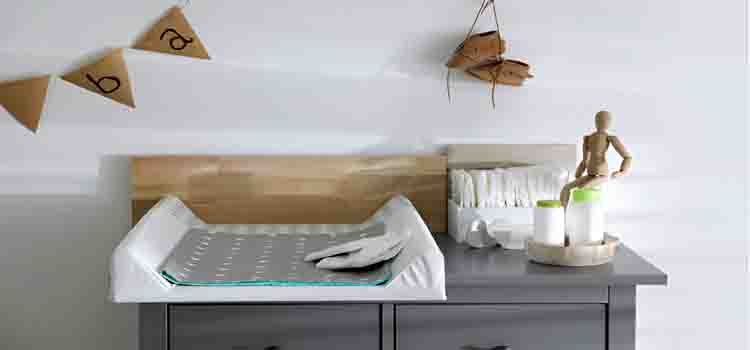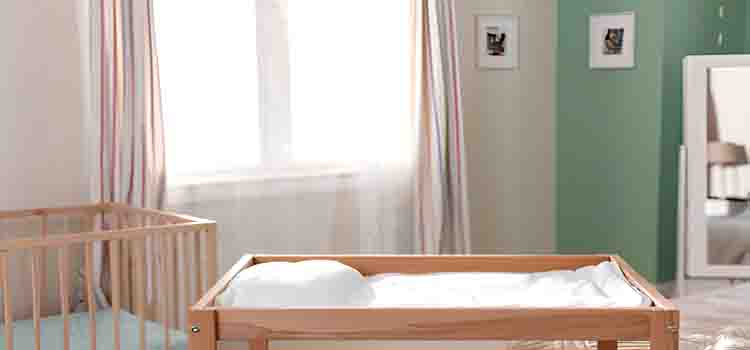As an Amazon Associate I earn from qualifying purchases.
The question that all parents ask themselves and others when preparing for a newborn is How many changing tables do I need? The answer to this question depends on many factors, including your living space, daily life habits, and whether you prefer convenience or simplicity.
Changing tables are a necessary item in most households, but how many are necessary and where they should be placed will vary from house to house.
In this guide, we’ll help you look through the considerations and decide on the correct number of changing tables for your family’s needs through more analysis of the core concerns.

What Is a Changing Table?
A diaper table is a piece of furniture specifically for the purpose of diaper changes. It usually features a flat top with a surface for your baby, safety rails to keep him from falling to the floor, and shelves, drawers, or a combination for holding the diapers, wipes, and other products you grab during a diaper change.
Changing tables are set up to be at just the right height for parents, which can be easier on your back when it’s time to change diapers.
Key Features of a Changing Table:
- Safety Rails: The safety rails help to keep your baby on the table.
- Storage Options: Look for changing tables with drawers or shelves to keep changing supplies neat and nearby.
- Height Considerations: A good changing table is tall enough to avoid bending down excessively, but not too high for easy access.
It’s essential to consider safety when choosing a changing table. Ensure that it has secure straps, sturdy legs, and a stable surface.
Factors to Consider Before Deciding
Before purchasing multiple changing tables, several factors should influence your decision:
Living Space:
If you live in a house with multiple stories, consider a changing table for each floor. This allows you to avoid lugging your child and stuff up and down steps, which is a lifesaver.
Lifestyle and Routine:
Will you be moving from room to room throughout the day or primarily staying put? If you are an active person, you may want more than one changing station. If you have a busy lifestyle or entertain often, having a changing station that’s central can be very convenient.
Budget Constraints:
Changing tables can be expensive, especially with added features like storage. If you’re on a budget, consider alternatives such as portable changing pads, which are more affordable but still provide the functionality you need.
Baby’s Growth and Development:
It could be difficult having only one changing table that grows with your baby. Of course, newborns get changed more often, and the dedicated space keeps things tidy. When your baby’s on the move, you might want to opt for something more accessible.
Storage Solutions
It includes a built-in storage pocket to keep your diaper-making supplies organized and within easy reach. For each changing station, think about how much storage is really required, given the location and how often it will be used.
Your first changing table should have ample storage for diapers, wipes, creams, and clothing. Secondary changing areas only need basic supplies stored in nearby drawers or baskets.
Height and Comfort
Opt for changing tables that are at an optimal height for the primary caregiver to avoid back pain during frequent diapering. Most traditional changing tables stand 36 to 40 inches high, but take your height into account while choosing.
Recommended Setups for Different Living Situations
Every home setup is different, so the number of changing tables you need depends on your living situation.
Small Apartments
For small living spaces, a single traditional changing table in the nursery and one or two portable changing pads in other rooms serve as an investment that meets most needs. Keep portable pads in your bedroom for changing at night to simplify late-night changes and in the family room for daytime easy access.
Single-Story Homes
Single-level homes generally work with one primary changing table in a nursery and a portable changing pad in the main living space. If you have the space, consider adding a wall-mounted changing station in a powder room, which provides a convenient place for fast changes near the kitchen or living room.
Multi-Level Homes
Homes with two floors are divided into two levels. Put your primary changing table in your upstairs nursery and set up a secondary diapering area on your main floor with either a second changing table or a designated area with a portable changing pad.
Homes with Multiple Children
Families with babies and toddlers will also appreciate additional changing spots to accommodate the needs of different children. If your budget allows, consider having two changing tables or supplement one main changing table with several portable changing pads spaced around the house.
Urban Living:
Portable or wall-mounted changing tables are also good choices for smaller urban spaces. These are easy to store and slide right under the bed or tuck under couches when not in use, so they’re great for apartments and smaller homes.
Shared Living Spaces:
If you share your home with others or live in a more open-plan space, a single changing table in a central location may suffice. You can add a portable changing pad to move around the house if needed.
Types of Changing Tables and Alternatives

If you’re hesitant about buying multiple changing tables, here are a few alternatives:
Traditional Changing Tables
Traditional changing tables create a designated changing space in the nursery. These function as your main changing station, usually set up in the nursery. I find most of my non-woodworking friends use a typical changing table, and it is big enough for them to fit next to each other to have everything.
Changing Table Dressers
Combo changing table dressers do double duty by offering a place to change your baby as well as a spot to store clothing. The larger of these pieces is perfect for nurseries with room for everything, and they grow with your child since you can remove the changing topper in time.
Portable Changing Pads
Portable Changing pads provide a flexible and convenient station in your home. These lightweight alternatives are much cheaper than full changing tables and can easily be put away when no longer needed.
Wall-Mounted Changing Stations
Wall-mounted changing tables save floor space and work well in smaller rooms or bathrooms. These fold-down options provide a secure changing surface when needed and tuck away neatly when not in use.
Changing Table Toppers:
Changing table toppers are pads that sit on top of a dresser or any flat surface. They provide the same functionality as a changing table but can be removed when not in use. This option saves space and money.
Convertible Furniture:
Convertible furniture, like a dresser that turns into a changing table, is a great choice to save space. These items grow with your baby and can continue to be used long after they are out of diapers.
Floor-Based Changing:
Some parents prefer to change diapers on the floor, especially as the baby becomes more mobile. While this option works for many, make sure the area is safe, clean, and comfortable.
Expert Opinions and Parental Insights
Pediatrician Recommendations:
Experts suggest parents make sure the changing table is sturdy and safe. Pediatricians also recommend having everything you need at arm’s length away to reduce the chances of any accidents.
Parent Testimonials:
Many parents find that having a changing table on each floor of the house is a game-changer. Others prefer the versatility of a portable changing pad. It’s important to find what works best for your home and routine.
Safety Guidelines:
No matter how many changing tables you have, safety should take precedence. Whenever using the changing table, always ensure the safety straps are properly in place to avoid any potential accidents, and never leave a child unattended on the changing table.
Money-Saving Tips
Start with Essentials
Start with one changing table and a couple of portable changing pads, and then re-evaluate after you’ve spent a few weeks with your baby. You may discover you will make do with fewer changing stations than you had originally anticipated, or you may find there are certain areas where you would like to add more infrastructure.
Shop Secondhand
Most changing tables are used for a relatively short duration of time and are an ideal second hand purchase. Look at local marketplaces, consignment stores, and parent groups for gently used picks..
DIY Solutions
Make DIY changing tables with regular dressers and secure changing pads. This is also often less expensive than buying a dedicated changing table, but you get more long-term life out of the furniture!
Conclusion: How Many Changing Tables Do I Need
In short, how many changing tables you’ll want depends on a few factors: the layout of your home, your lifestyle, and your baby’s age. Some people may only need one change table; however, others may like to have a second one in another part of the home.
And don’t forget, alternatives such as swappable toppers, portable pads, and convertible furniture can also go a long way to making the process easier. Whatever you do, be sure to play it safe and go with what suits your own family best.
RELATED: How high should a changing table be? A Comprehensive Guide
FAQs: How Many Changing Tables Do I Need
It depends on your home’s layout and daily routine. Multiple changing tables are ideal for multi-level homes.
Yes, a changing table topper is space-saving and can sit on top of any flat surface.
Portable changing mats are the lightweight solution for new parents on the move- perfectly sized for changing on the go!
Place the changing table in a central, accessible location for ease of use and safety.
Always use safety straps for your baby and never leave him unattended on the table.
Amazon and the Amazon logo are trademarks of Amazon.com, Inc, or its affiliates.
Leave a Reply